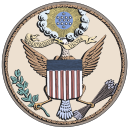 |
|
Union states in the American Civil War |
|---|
|
|
| Dual governments |
| Territories and D.C. |
During the American Civil War, the State of Ohio played a key role in providing troops, military officers, and supplies to the Union army. Due to its central location in the Northern United States and burgeoning population, Ohio was both politically and logistically important to the war effort. Despite the state's boasting a number of very powerful Republican politicians, it was divided politically. Portions of Southern Ohio followed the Peace Democrats and openly opposed President Abraham Lincoln's policies. Ohio played an important part in the Underground Railroad prior to the war, and remained a haven for escaped and runaway slaves during the war years.[1]
The third most populous state in the Union at the time, Ohio raised nearly 320,000 soldiers for the Union army, third behind only New York and Pennsylvania in total manpower contributed to the military and the highest per capita of any Union state.[2][3] Several leading generals were from Ohio, including Ulysses S. Grant, William T. Sherman, and Philip H. Sheridan. Five Ohio-born Civil War officers would later serve as the President of the United States.[4] The Fighting McCooks gained fame as the largest immediate family group ever to become officers in the U.S. Army.[5]
The state was spared many of the horrors of war as only two minor battles were fought within its borders. Morgan's Raid in the summer of 1863 spread fear but little damage.[6] Ohio troops fought in nearly every major campaign during the war. Nearly 7,000 Buckeye soldiers were killed in action. Its most significant Civil War site is Johnson's Island, located in Sandusky Bay of Lake Erie. Barracks and outbuildings were constructed for a prisoner of war depot, intended chiefly for officers. Over three years more than 15,000 Confederate men were held there. The island includes a Confederate cemetery where about 300 men were buried.[7]
- ^ Harper, pp. 4-15.
- ^ "Senate President Keith Faber says more than 300,000 Ohioans served in the Union Army during the Civil War, more per capita than any other state". politifact.com.
- ^ Reid, Vol. 1, p. 160; U.S. Census if 1860.
- ^ Appletons Cyclopedia of American Biography.
- ^ Whalen, Charles and Barbara, The Fighting McCooks: America's Famous Fighting Family, Westmoreland Press, 2006.
- ^ Brown, Dee A., Morgan's Raiders. New York : Konecky & Konecky, 1959. ISBN 0-914427-79-2.
- ^ Johnson's Island Preservation Society Archived 2012-08-03 at archive.today
